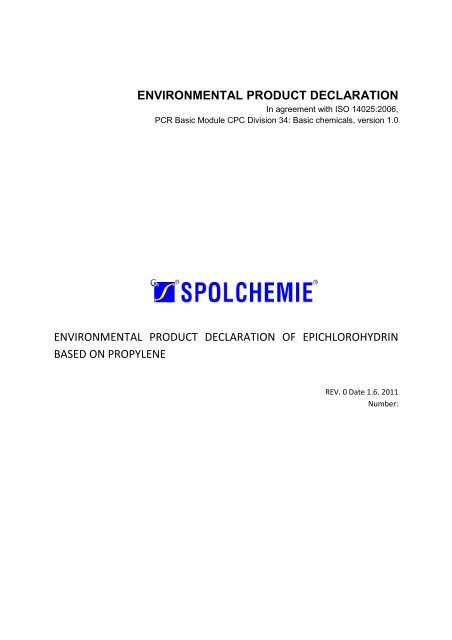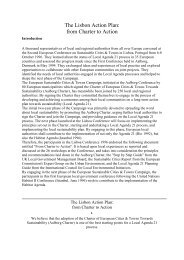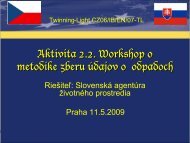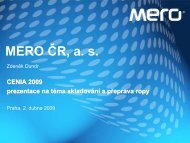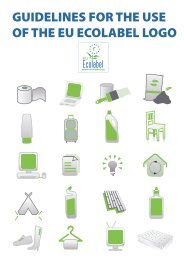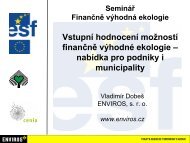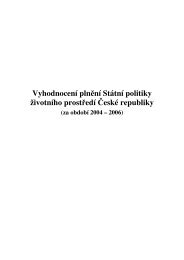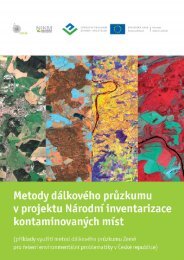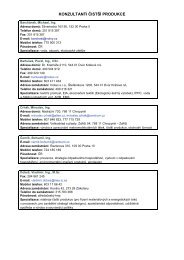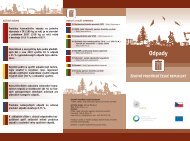EPD EPIC P_vysl
EPD EPIC P_vysl
EPD EPIC P_vysl
You also want an ePaper? Increase the reach of your titles
YUMPU automatically turns print PDFs into web optimized ePapers that Google loves.
ENVIRONMENTAL PRODUCT DECLARATION<br />
In agreement with ISO 14025:2006,<br />
PCR Basic Module CPC Division 34: Basic chemicals, version 1.0<br />
ENVIRONMENTAL PRODUCT DECLARATION OF <strong>EPIC</strong>HLOROHYDRIN<br />
BASED ON PROPYLENE<br />
REV. 0 Date 1.6. 2011<br />
Number:
Organization: Spolek pro chemickou a hutní výrobu, akciová<br />
společnost<br />
(The record in the Company Register (effective<br />
from 31.12. 1990) was ordered by the District<br />
Court in Ústí nad Labem (27.12. 1990, f.m. Sa 47)<br />
Address Revoluční 1930/86<br />
400 32 Ústí nad Labem, Czech Republic<br />
Statutory body Paul Yianni, CEO<br />
<strong>EPD</strong> representative Jan Votava, Quality & REACH Manager<br />
Contact Phone: +420 477 162 037<br />
Fax: +420 477 163 244<br />
e-mail: info@spolchemie.cz<br />
Registration No. / VAT No.<br />
00011789 / CZ699001352<br />
www.spolchemie.cz<br />
Product: Epichlorohydrin P (Epichlorohydrin made from propylene (CAS 106-89-8))<br />
Use:<br />
The epichlorohydrin is used in a wide variety of applications. It is a basic chemical for<br />
broad number of chemical synthesies.<br />
Weight /kg/: ECH is liquid, volume and weight depends on customer request<br />
Product lifetime The products are under warranty for 365 days - 1 years. If the product is stored under<br />
/days/:<br />
producer recommended condition, the product lifetime is approximately 3 years.<br />
Hazardous Yes/No<br />
substance<br />
contents:<br />
UN CPC: CPC Division 34: Basic chemicals (subclass 3417)<br />
Page 2 of 11
1 PROGRAMME RELATED INFORMATION<br />
1.1 NAME OF THE PROGRAMME AND PROGRAMME OPERATOR<br />
Programme operator for the International <strong>EPD</strong>®system is the International <strong>EPD</strong> Consortium (IEC)<br />
Vasagatan 15-17, Stockholm, Sweden<br />
Postal address: Vasagatan 15-17, SE-111 20 Stockholm<br />
Telephone: +46 8 700 66 90<br />
Telefax: +46 8 700 66 99<br />
E-mail: info@environdec.com<br />
WWW: www.environdec.com<br />
For information about the international <strong>EPD</strong> ® system please contact:<br />
Joakim Thornéus at joakim@environdec.com<br />
Adriana Del Borghi at adry@unige.it<br />
1.2 THE REFERENCE PCR DOCUMENT<br />
The reference documents for this <strong>EPD</strong> are General Programme Instructions (GPI, 2008) and PCR Basic<br />
Module, 2010. Product Category Rules (PCR) are specified for specified information modules “gateto-gate”,<br />
so called core modules. The structure and aggregation level of the core modules is defined<br />
by the United Nation Statistics Division - Classification Registry CPC codes (http://unstats.un.org).<br />
<strong>EPD</strong>s from different programmes may not be comparable.<br />
1.3 REGISTRATION NUMBER<br />
The registration number of this <strong>EPD</strong> is:<br />
1.4 DATE OF PUBLICATION AND VALIDITY<br />
The publication date of this <strong>EPD</strong> is: April, 2011<br />
This <strong>EPD</strong> is valid until: April, 2014<br />
1.5 GEOGRAPHICAL SCOPE OF APPLICATION OF <strong>EPD</strong><br />
The geographical scope of this <strong>EPD</strong> is fully international.<br />
1.6 INFORMATION ABOUT THE YEAR OR REFERENCE PERIOD OF THE UNDERLYING<br />
DATA TO THE <strong>EPD</strong><br />
The reference period to this <strong>EPD</strong> is year 2006. Data shown below refers to 2006 and have been<br />
collected directly from the Spolchemie plant. Other data used from the GaBi database (PE<br />
International, 2010) were taken.<br />
2 PRODUCT RELATED INFORMATION<br />
Trade name of product: Epichlorohydrin P (Epichlorohydrin made from propylene (CAS 106-89-8))<br />
Unequivocal identification of the product according to the CPC classification system: CPC Division 34:<br />
Basic chemicals (subclass 3417).<br />
Page 3 of 11
2.1 SPECIFICATION OF THE COMPANY<br />
The epichlorohydrin is produced in Spolek pro chemickou a hutní výrobu, akciová společnost<br />
(Spolchemie) located in Ústí nad Labem, Czech Republic. (for more see also www pages)<br />
Main activities of the Company are Research, Development, Production and processing of chemical<br />
and biochemical products and trading in these products.<br />
Spolchemie manufactures about 500 products within three main product profiles:<br />
Chlor-alkali based compounds<br />
Special Inorganic compounds<br />
Synthetic resins<br />
Sodium and potassium hydroxide (soda and potash lye).<br />
Chlorine, hydrochloric acid, sodium hypochlorite.<br />
Epichlorohydrin, allyl chloride.<br />
Potassium permanganate.<br />
Aluminium oxide, synthetic sapphire.<br />
Basic and modified low, medium, and high molecular epoxide<br />
resins.<br />
Alkyd and polyester resins. Lacquer colophony-type resins. Water<br />
soluble resins.<br />
2.2 INTENDED USE<br />
Epichlorohydrin is a versatile product widely used in polymer / resin chemistry. The main consumer<br />
is liquid epoxy resin industry. It is also used in production of reactive diluents (glycidyl ethers),<br />
elastomers, glycidyl methacrylatess, polyamide-epichlorhydrin wet strenght resin in paper industry,<br />
ion-echange resin, polyamide water treatment chemicals, crosslinking agent in modified starch,<br />
polyether rubber in automotive etc..<br />
2.3 SPECIFICATION OF THE PRODUCT<br />
This <strong>EPD</strong> is for production of epichlorohydrin (CAS 106-89-8) which is sold on international market.<br />
Epichlorohydrin is intermediate product for number of synthesies.<br />
2.4 CONTENT OF MATERIALS AND CHEMICAL SUBSTANCES<br />
The hazardous chemical substances included in the products manufactured by Spolchemie plant is<br />
the following: epichlorohydrin – 100%.<br />
The product is a pure chemical compound (CAS 106-89-8).<br />
Classification of the substance:<br />
H226, H301, H311,H314, H317, H318, H331, H350, H361<br />
P202, P3210, P260, P260B, P280, P301+330+331, P303+361+353,P304+340, P305+351+338,<br />
P308+313, P403+233, P501,<br />
T, R10, R34, R45-23/24/25, S1/2, S45, S53<br />
2.5 LIFE CYCLE ASSESSMENT AND ENVIRONMENTAL PERFORMANCE<br />
The LCA calculations rules used for this declaration outlines the overall requirements to follow for<br />
the International <strong>EPD</strong>®system. These rules follow the International standards ISO 14040 and ISO<br />
14044. The international <strong>EPD</strong>®system has adopted an LCA calculations procedure which is separated<br />
into different life cycle stages:<br />
• Upstream processes (from cradle-to-gate)<br />
• Manufacturing processes (from gate-to-gate)<br />
Page 4 of 11
• Downstream processes (from gate-to-grave)<br />
The reference LCA study for this <strong>EPD</strong> is ECH G LCA (Kočí, 2010). It was also used to evaluate carbon<br />
footprint following with other environmental impacts due to the production of epichlorohydrin in<br />
order to support the communication of the Spolchemie environmental performances. For this study<br />
it was used the Life Cycle Assessment method which is regulated by the international standards ISO<br />
140 40 and ISO 140 44.<br />
The product system for this LCA has been described by using specific data when available; generic<br />
data have been used in accordance with PCR and GPI requirements.<br />
2.6 FUNCTIONAL/DECLARED UNIT<br />
Declared unit is selected as 1000 kg of the product – epichlorohydrin. No packaging of the final<br />
product was assessed, as no specific packaging for this product is used.<br />
The annual total 2006 epichlorohydrin production resulted in a value of about 6 900 tons that<br />
corresponds to 6 900 DU. The capacity of Spolchemie plant is production of 8 000 tons per year that<br />
corresponds to 8 000 DU.<br />
2.7 SYSTEM BOUNDARIES<br />
The boundaries of the industrial system considered include all the phases from raw materials<br />
extraction to final production. In detail, the system comprises: core raw material production,<br />
epichlorohydrin production, treatment of off gases in incinerator, treatment of waste organic in<br />
incinerator, treatment of waste water in industrial waste water treatment plant. As stated in GPI<br />
(GPI, 2008) all elementary flows at resource extraction are included, except for the flows that fall<br />
under the general 1% cut off rule.<br />
Page 5 of 11
Figure 1 System boundaries<br />
Production of<br />
chemicals<br />
Production of<br />
energy and fuel<br />
products<br />
Upstream<br />
processes<br />
EPI<br />
Production<br />
Manufacturing<br />
processes<br />
Spolchemie<br />
INCINERATOR<br />
Spolchemie<br />
WASTE WATER<br />
TREATMENT<br />
ECH – Final product<br />
Downstream<br />
processes<br />
The upstream processes include the following inflow of raw materials and energy wares needed for<br />
the production of the product (PCR Basic Module, 2008):<br />
• Extraction of resources<br />
• Transport of resources to refinement and transport of materials to manufacturer<br />
• Refinement of resources<br />
• The production processes of energy wares used in the extraction, refinement and<br />
manufacturing<br />
• Production of auxiliary products used such as detergents for cleaning etc.<br />
The core processes include (PCR Basic Module, 2008):<br />
• Manufacturing of the epichlorohydrin<br />
• Storage<br />
• Treatment of waste generated from the manufacturing of main parts and assembly of the<br />
product<br />
Downstream processes defined in GPI (GPI, 2008) are not relevant as no packaging of final product is<br />
realized as transport to costumers in tanks is realized.<br />
2.8 DESCRIPTION OF MANUFACTURING PHASE<br />
Epichlorohydrin from propylene is produced in three reaction steps starting from high temperature<br />
chlorination of propylene in vapour phase to give intermediate allychloride, following by addition of<br />
hypochlorous acid in aqueous phase to form intermediate dichlorpropanols and finishing by alkaline<br />
dehydrochlorination and life steam stripping to produce epichlorohydrin. Finally the crude<br />
epichlorohydrin is purified by series of distillation steps from which the product is transferred to<br />
Page 6 of 11
final storage / loading facilities. Chlorinated organic wastes are incinerated, waste water are treated<br />
by high-efficient bio-treatment plant.<br />
2.9 TRANSPORT DATA<br />
The delivery from suppliers is carried out by truck, train and/or pipeline. As the Spolchemie plant is<br />
located in Ústí nad Labem, where other chemical plants are operated, some chemicals are produced<br />
on site. Transport of other chemicals was modeled using GaBi databasis (PE International, 2010).<br />
2.10 DESCRIPTION OF USE PHASE<br />
Epichlorohydrin is either processed in captive Liquid Epoxy Resin plant or sold to customers all over the world<br />
and ends up in different chemical syntheses. The product is not considered to contribute to an increased<br />
environmental load during the use phase and it will eventually end up together with other chemical waste.<br />
2.11 RECYCLING AND END-OF-LIFE INFORMATION<br />
Since the product is located at the beginning of several sectors, end of life scenarios are not included<br />
in this declaration.<br />
3 ENVIRONMENTAL PERFORMANCE-RELATED INFORMATION<br />
The environmental parameters are declared for up-stream processes and for core processes<br />
(manufacturing). Inclusion of use phase into declaration is not reasonable, as stated above. As stated<br />
in reference PCR basic module for Basic chemicals (PCR Basic Module, 2010) the environmental<br />
performance of the product is divided on use of resources, potential impacts and other indicators. All<br />
environmental performance is reported per declared unit.<br />
3.1 USE OF RESOURCE<br />
Table 1 reports the main consumption of resources for epichlorohydrin production. Use of resources<br />
without energy content is expressed in kg/D.U. The use of resources with energy content is<br />
expressed in MJ/D.U. All energy data are expressed as net caloric value. Electricity consumption<br />
during manufacturing (core) processes is expressed in kWh/D.U. (PCR Basic Module, 2010).<br />
Table 1 Resource consumption associated with the epichlorohydrin manufacturing phase. Data are referred to D.U.<br />
Unit Total ECH Core Upstream<br />
production<br />
Non-renewable resources<br />
Material resources<br />
Sodium chloride (rock salt) kg/D.U. 1,95E+03 1,06E+02 1,84E+03<br />
Crude oil for material production kg/D.U. 6,86E+02 0,00E+00 6,86E+02<br />
Other material (non energy) resources kg/D.U. 1,67E+05 1,15E+05 5,22E+04<br />
Non renewable energy resources (Total) MJ/D.U. 1,42E+05 4,49E+04 9,68E+04<br />
Crude oil (resource of energy and material) MJ/D.U. 3,34E+04 9,39E+02 3,24E+04<br />
Hard coal (resource) MJ/D.U. 3,60E+04 2,42E+04 1,18E+04<br />
Lignite (resource) MJ/D.U. 2,14E+04 1,06E+04 1,07E+04<br />
Natural gas (resource) MJ/D.U. 2,84E+04 2,48E+03 2,59E+04<br />
Uranium (resource) MJ/D.U. 2,25E+04 6,67E+03 1,58E+04<br />
Water liter/D.U. 9,56E+04 8,35E+04 1,21E+04<br />
Page 7 of 11
Renewable energy resources MJ/D.U. 2,60E+03 5,48E+02 2,05E+03<br />
Primary energy from hydro power MJ/D.U. 1,30E+03 3,59E+02 9,40E+02<br />
Primary energy from solar energy MJ/D.U. 2,12E+02 1,17E+02 9,50E+01<br />
Primary energy from wind power MJ/D.U. 1,08E+03 7,20E+01 1,01E+03<br />
Renewable fuels MJ/D.U. 5,07E-04 4,20E-05 4,65E-04<br />
Wood MJ/D.U. 6,98E-01 1,47E-01 5,52E-01<br />
Electricity consumption (electricity consumption<br />
during manufacturing)<br />
kWh/D.U. 1451,418 1451,418 -<br />
3.2 POTENTIAL ENVIRONMENTAL IMPACT<br />
Table 2 reports results of environmental impacts resulted from characterization models<br />
recommended by <strong>EPD</strong>® programme (PCR Basic Module, 2010) of epichlorohydrin production. Total<br />
pollutant emissions from the operations included in the system boundaries are as potential<br />
environmental impacts.<br />
Table 2 Main environmental results associated with the epichlorohydrin manufacturing phase using CML 2001<br />
characterization with respect to (PCR Basic Module, 2010). Data are referred to D.U.<br />
Acidification (AP)<br />
[kg SO 2 -Equiv./D.U.]<br />
Eutrophication (EP)<br />
[kg Phosphate-Equiv./D.U.]<br />
Global Warming (GWP 100 years)<br />
[kg CO 2 -Equiv./D.U.]<br />
Ozone Layer Depletion (ODP, steady state)<br />
[kg CFC11-Equiv./D.U.]<br />
Photochemical Ozone Creation (POCP)<br />
[kg Ethene-Equiv./D.U.]<br />
Total ECH production Core Upstream<br />
4,04E+01 3,10E+01 9,34E+00<br />
1,93E+00 9,42E-01 9,92E-01<br />
8,91E+03 3,64E+03 5,27E+03<br />
6,06E-04 1,80E-04 4,26E-04<br />
2,63E+00 1,66E+00 9,68E-01<br />
3.3 OTHER INDICATORS<br />
3.3.1 MATERIAL SUBJECT FOR RECYCLING<br />
During the production of one D.U. of epichlorohydrin 632,2 kg of hydrochloric acid HCl (17,4% w/w)<br />
as waste product is collected and send for recovery.<br />
3.3.2 HAZARDOUS AND OTHER WASTE<br />
Hazardous waste is defined by regional directives. In different regions substances of different<br />
properties are characterized as hazardous waste. For purpose of this <strong>EPD</strong> only waste and hazardous<br />
waste from core processes located in Spolchemie, Czech Republic are reported.<br />
Table 32 Hazardous and other wastes. Data are referred to D.U.<br />
kg/D.U.<br />
Hazardous waste - total 85,00<br />
Sludge [Hazardous waste] 85,00<br />
Page 8 of 11
Other waste 0,00<br />
3.3.3 TOXIC SUBSTANCES<br />
Emission of toxic substances is expressed in kg/D.U.<br />
Table 43 Emissions of toxic substances. Data are referred to D.U.<br />
kg/D.U. Total Core processes Upstream processes<br />
Heavy metals to air 6,96E-03 3,46E-03 3,50E-03<br />
Group NMVOC to air 1,78E+00 2,60E-01 1,52E+00<br />
Group PAH to air 1,70E-03 3,31E-05 1,66E-03<br />
Halogenated organic emissions to air 7,82E-04 2,29E-04 5,53E-04<br />
Heavy metals to fresh water 3,39E+00 1,58E+00 1,81E+00<br />
Halogenated organic emissions to fresh water 2,14E-06 2,99E-07 1,84E-06<br />
Heavy metals to sea water 5,28E-03 2,12E-04 5,07E-03<br />
Heavy metals to industrial soil 2,04E-01 9,87E-03 1,94E-01<br />
4 ADDITIONAL ENVIRONMENTAL INFORMATION<br />
Obtained certificates EN ISO 9001 and EN ISO 14001, and the commitment of whole company´s<br />
staff to quality give the customers a guarantee of a standard quality of products. Spolchemie has<br />
established and applied a combined management system for development, production, sales and<br />
services ofproducts of Inorganic, Specialities and Resins. An audit was performed, Report No.<br />
015619. Proof has been furnished that the requirements according to EN ISO 9001 and ISO 14001 are<br />
fulfilled since 1997. For actual certificate see www.spolchemie.cz.<br />
Spolchemie has established and applied an Occupational Health & Safety Management System<br />
for development, production, sales and services of products of Inorganic, Resins and Dyestuff<br />
sections. An audit was performed, Report No. 060021. Proof has been furnished that the<br />
requirements according to OHSAS 18001 are fulfilled since 1997. For actual certificate see<br />
www.spolchemie.cz.<br />
Obtained certificates RESPONSIBLE CARE, in chemical industry. Spolchemie are oriented for<br />
enhancement of environmental, health and safety is fulfilled since 1997. For actual certificate see<br />
www.spolchemie.cz.<br />
5 MANDATORY STATEMENT<br />
The same products environmental declarations from different programmes need not to be<br />
comparable. Downstream processes are excluded what is in relation to (GPI, 2008).<br />
5.1 MEANS OF OBTAINING EXPLANATORY MATERIALS<br />
For information about this environmental declaration:<br />
Ing. Jan Votava,<br />
Tel.: +420 47 716 3063<br />
e-mail: votava@spolchemie.cz<br />
For information on Spolchemie and Spolchemie contact:<br />
Tel.: 420 477 161 111<br />
e-mail: info@spolchemie.cz<br />
www.spolchemie.cz<br />
Page 9 of 11
5.2 REFERENCES<br />
The main references used to prepare this <strong>EPD</strong> are:<br />
- PCR Basic Module for Basic Chemicals (PCR Basic Module, 2010).<br />
- Kočí, V. LCA study of epichlorohydrin based on propylene, Praha, 2010;<br />
- General Programme Instructions for <strong>EPD</strong>, 2008-02-29;<br />
- Announcement of Rules of the National Eco-Labelling Programme publication, Official Journal of the<br />
Ministry of the Environment of the Czech Republic, annual vol. XVII, vol. 8, 2007.<br />
5.3 VALIDITY OF THE <strong>EPD</strong><br />
If changes in any of the environmental impacts are larger than +- 5% the <strong>EPD</strong> shall be adjusted.<br />
Regardless, the <strong>EPD</strong> shall be reviewed every three years. Next review is planned in year 2014.<br />
This declaration was generated by doc. Ing. Vladimír Kočí, Ph.D. e-mail: Vladimir.Koci@lcastudio.cz<br />
Page 10 of 11
Independent verification of the declaration and data accordance to ISO<br />
14025:2006:<br />
internal<br />
Programme:<br />
Verification procedure:<br />
external<br />
<strong>EPD</strong> ® system (www.environdec.com)<br />
ISO 14025: 2006 Environmental labels and<br />
declarations – Type III environmental declarations –<br />
principle and procedures<br />
General Programme Instructions for Environmental<br />
Product Declarations, <strong>EPD</strong>, version 1.0<br />
Rules of the National Eco-Labelling Programme<br />
Product category rules (PCR): PCR Basic Module Basic chemicals, version 1.0,<br />
dated 2010-11-30<br />
Výzkumný ústav pozemních staveb - Certifikační společnost, s.r.o., (Building Research Institute<br />
– Certification Company, Ltd.) – Certification Body for <strong>EPD</strong> verification no. 3013 accredited by<br />
Czech Accreditation Institute made independent verification of <strong>EPD</strong> in 5 th April 2011 in<br />
agreement with ISO 14025:2006. The certificate results from the Final report no. P-3013<strong>EPD</strong>-<br />
11-0205 from 1 st June 2011 that includes certification body ascertaining and validity conditions<br />
of the certificate.<br />
The verified <strong>EPD</strong> has reg. no. 3013<strong>EPD</strong>-11-0205-01.<br />
Registration number 3013<strong>EPD</strong> - 11 - 0205 from 1 st June 2011<br />
Certified validity<br />
Contact<br />
to 1 st June 2014<br />
Výzkumný ústav pozemních staveb - Certifikační<br />
společnost, s.r.o., Pražská 16, 102 21 Praha 10 –<br />
Hostivař<br />
Czech Republic<br />
tel.: +420 271751148 fax: ++420 241017241<br />
e-mail: votockova@vups.cz<br />
1 st June 2011<br />
Tereza Votočková<br />
Head of Certification Body<br />
stamp<br />
Distributed to:<br />
No. 1 Spolek pro chemickou a hutní výrobu, akciová společnost<br />
No. 2 Certification Body<br />
No. 3 Mgr. Tereza Votočková, head of Certification Body<br />
No. 4 CENIA<br />
Page 11 of 11


